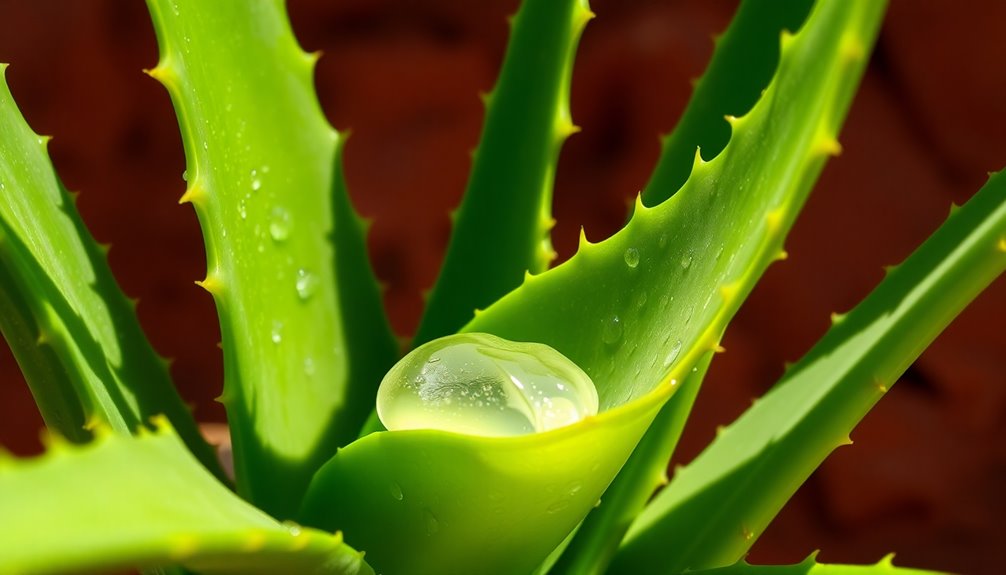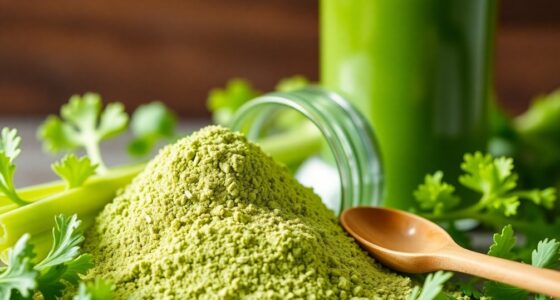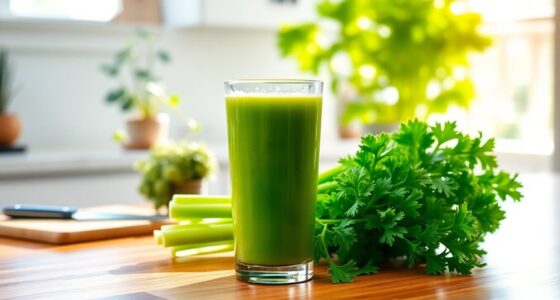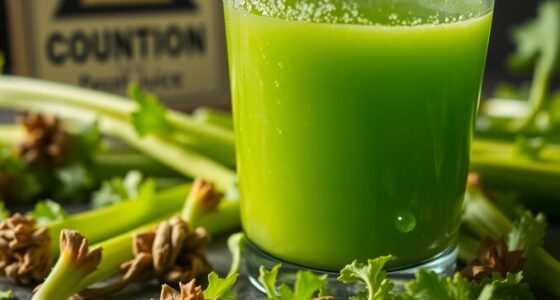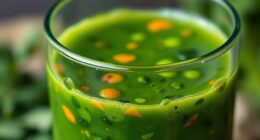Aloe vera isn't just any plant; it's a powerhouse packed with healing properties and rich history. Known since ancient Egypt for its beauty and healing benefits, its soothing gel helps treat burns and skin irritations. Growing in warm, dry climates, it thrives with minimal care. Plus, its antioxidant properties can reduce inflammation. Curious about its many uses and how to care for this versatile plant? There's even more to discover!
Key Takeaways
- Aloe vera, known as the "plant of eternity," has a rich history dating back to ancient Egypt for its therapeutic properties.
- Its unique polysaccharides support healing and enhance skin recovery from injuries and irritations.
- The gel offers soothing, hydrating, and anti-inflammatory benefits, making it a staple in skincare products.
- While aloe vera has many health benefits, caution is needed due to potential toxicity in certain forms and species.
- Understanding the plant's characteristics and proper usage can maximize its healing potential while minimizing risks.
Historical Significance of Aloe Vera

Aloe vera has captivated people for thousands of years, and its historical significance is hard to overlook.
You'll find that this remarkable plant was first documented in ancient Egypt, where it was revered for its healing properties and associated with beauty care. Mentioned in historical texts like the Old Scriptures, Aloe vera's role in various cultures as a source of healing is well established.
Native to North Africa, it's naturalized worldwide, thanks to its resilience. Known as the "plant of eternity," Aloe vera was even used in embalming practices, symbolizing eternal life.
Across different civilizations, its medicinal benefits have solidified Aloe vera's reputation as a powerful healing plant, making it an enduring symbol of wellness throughout history.
Unique Properties and Characteristics

The unique characteristics of Aloe vera set it apart from other plants, making it a fascinating choice for both gardening enthusiasts and health advocates. This succulent thrives in warm, dry climates and can reach over two and a half feet tall outdoors, while indoor versions often appear greener and more elongated.
The pale grey-green leaves, adorned with subtle white spots and widely spaced teeth, distinguish Aloe vera from cacti. Its unique properties include a special polysaccharide that supports healing by binding growth factors in wounds.
For ideal growth, Aloe vera needs well-draining soil and full sun exposure, blooming year-round with yellow flowers. Be mindful, as it's often misidentified with similar species, which can lead to confusion about their uses.
Healing Mechanisms and Benefits
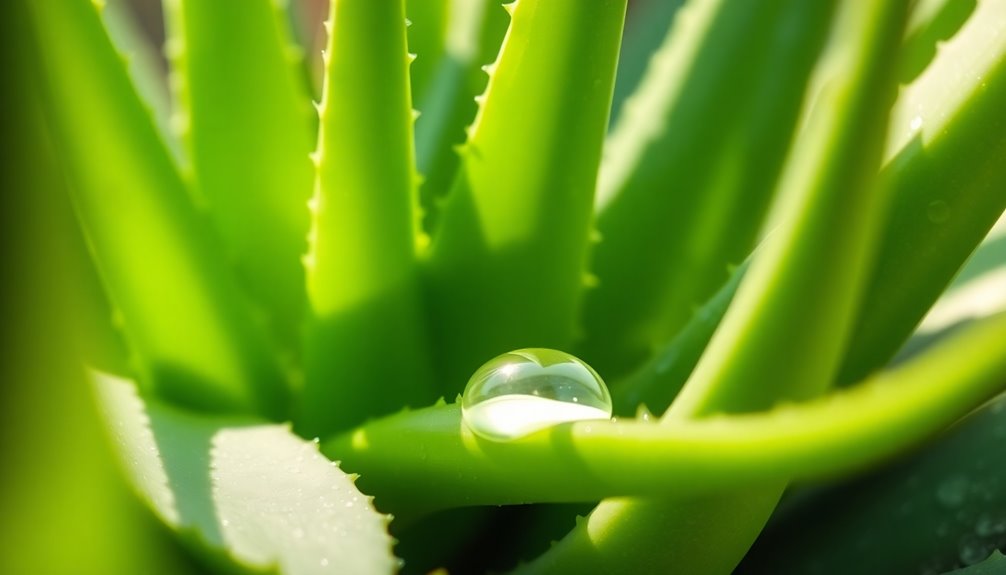
Aloe vera's special polysaccharides play an essential role in healing, helping your skin recover faster from injuries.
You'll find that its gel not only soothes minor burns and rashes but also promotes overall skin health.
As you explore its benefits, you'll appreciate how this ancient remedy remains relevant in modern healing practices.
Polysaccharide Healing Properties
While many plants offer healing properties, few can match the unique polysaccharides found in Aloe vera that greatly enhance the wound healing process. This special polysaccharide binds growth factors in wounds, preventing their destruction and promoting faster recovery from skin injuries like bedsores and minor burns.
Research led by Dr. Ian Tizard reveals how this polysaccharide contributes to the wound treatment mechanisms of Aloe vera, demonstrating that its healing effects are more pronounced compared to other plants.
As ongoing research continues to uncover its potential, insights may lead to the development of new therapies utilizing Aloe vera's polysaccharide for more effective wound treatments. Embracing this plant can truly revolutionize your approach to healing.
Skin Recovery Benefits
When you consider effective remedies for skin recovery, Aloe vera quickly stands out due to its remarkable healing mechanisms. This plant contains a special polysaccharide that binds growth factors in wounds, enhancing the healing process and preventing the loss of these critical components.
The soothing gel of Aloe vera effectively treats minor burns, cuts, and skin irritations by forming a protective barrier that promotes faster healing. Research shows that it accelerates recovery from bedsores and other skin injuries, boasting superior effects compared to many other plants.
Its antioxidant properties also help reduce inflammation and irritation, further supporting skin recovery. Historically, ancient civilizations recognized Aloe vera's remarkable benefits for treating skin ailments and promoting beauty and longevity.
Cultivation and Growth Conditions
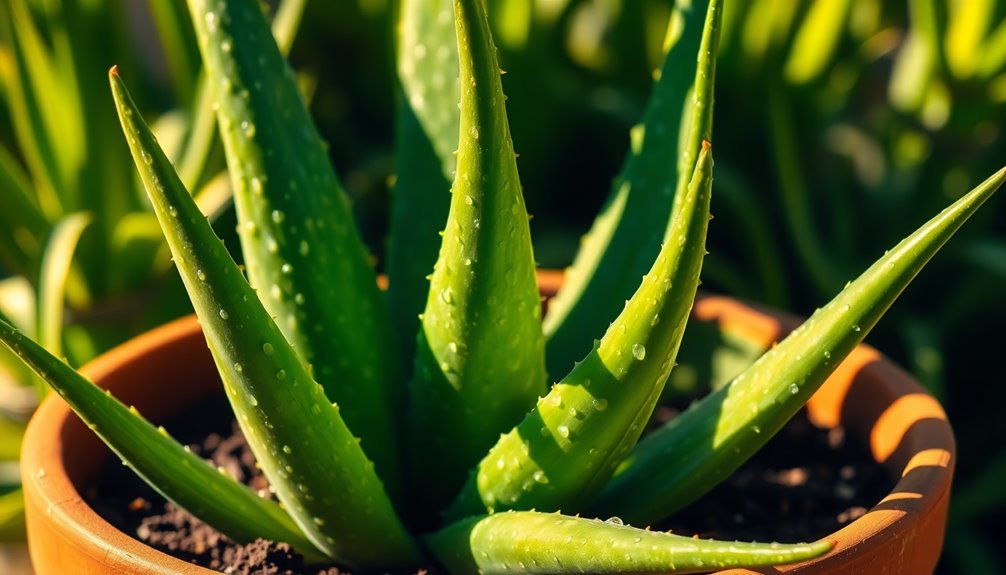
To successfully cultivate Aloe vera, you'll want to provide it with well-draining soil and plenty of sunlight.
This resilient Aloe vera plant thrives in bright light, ideally soaking up full sun for 6 to 8 hours each day. Make sure to use sandy soil mixes, as they facilitate drainage and prevent root rot.
While it can tolerate temperatures above 27°F, avoid exposing it to colder conditions that can damage its leaves.
Be cautious with watering; overwatering can lead to root rot, while prolonged dryness can sap moisture from its leaves.
Cosmetic and Topical Applications
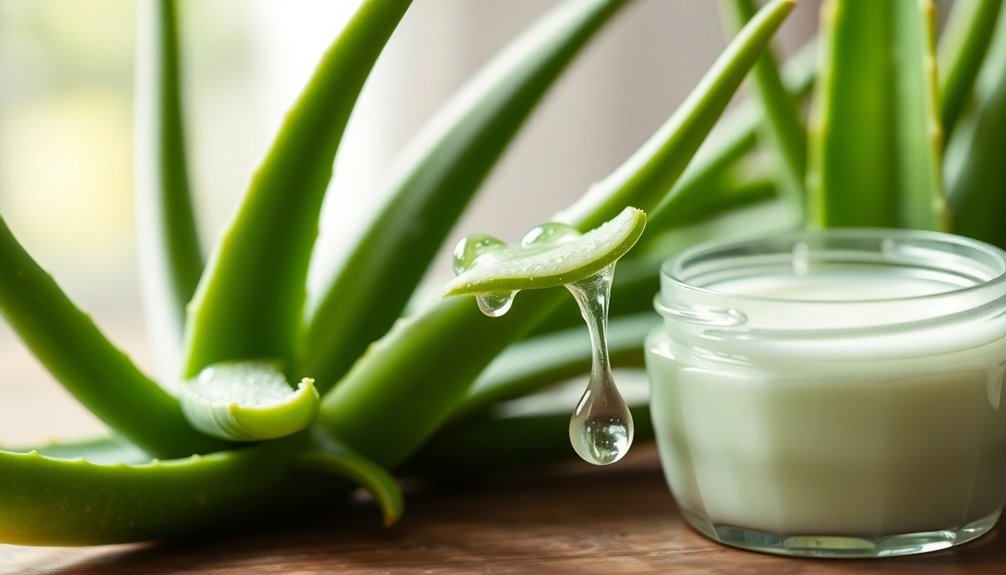
Aloe vera isn't just a hardy plant; its gel is a powerhouse in the cosmetic and skincare industry. You'll find it in numerous skincare formulations, celebrated for its soothing and hydrating properties. Whether you're treating sunburn or addressing skin conditions, Aloe vera gel works wonders. Additionally, its anti-inflammatory properties make it a popular choice for soothing irritated skin.
Here's a quick overview of its benefits:
| Benefit | Properties | Common Uses |
|---|---|---|
| Soothing | Antibacterial | Sunburn treatment |
| Hydration | Anti-inflammatory | Moisturizers |
| Skin repair | UV protection | Wound healing |
| Versatile for skin types | Natural alternative | Daily skincare routines |
Embrace Aloe vera gel for a natural boost to your skincare regimen, and enjoy its myriad of benefits!
Safety and Toxicity Concerns
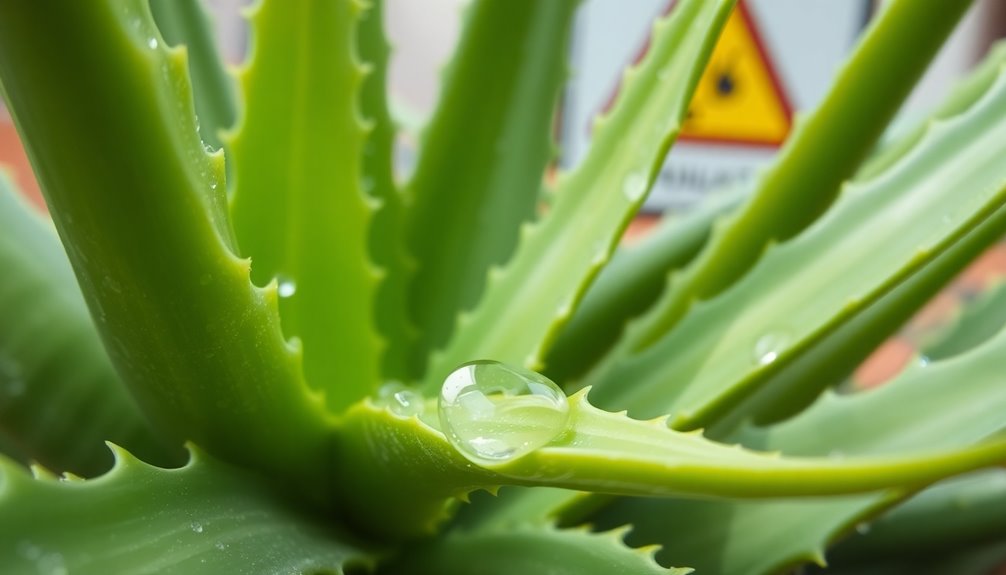
While many people celebrate Aloe vera for its skin benefits, it’s essential to take into account the safety and toxicity concerns associated with its use. Some varieties of aloe, particularly the ones with yellow latex, can cause gastrointestinal distress if ingested and may potentially interact with certain medications. To ensure safe usage, it’s important to consult with a healthcare professional and learn about edible aloe vera, which is specifically cultivated for consumption and offers health benefits without the associated risks of its non-edible counterparts.
Aloe latex, which contains aloin, has raised alarms due to potential carcinogenic effects. To navigate these issues, consider the following:
- Aloin Removal: Many aloe supplements have eliminated aloin to reduce toxicity while preserving beneficial properties.
- Species Safety: The safety of various aloe species isn't well-researched, leaving room for potential risks.
- Product Awareness: Always check for high aloe content and minimal additives to avoid adverse effects.
Modern Applications and Uses
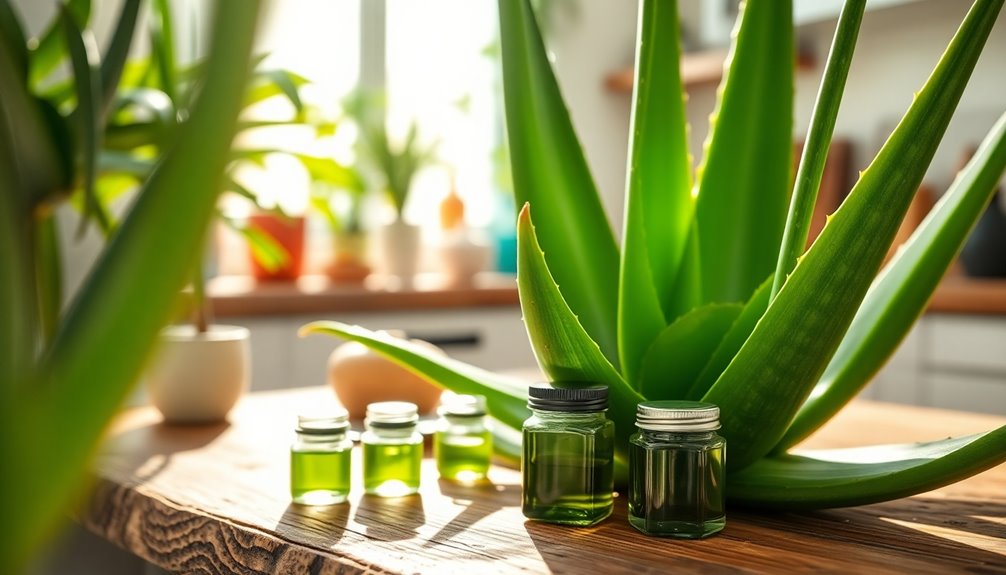
With safety concerns in mind, many are now exploring the various modern applications and uses of Aloe vera that highlight its remarkable benefits.
Aloe vera is widely found in skincare products, especially in the form of aloe gel, due to its antibacterial and anti-inflammatory properties. This gel soothes pain from minor burns and cuts, making it a go-to for first aid and cosmetic treatments.
Beyond topical use, Aloe vera plays a role in dietary supplements, offering potential digestive health benefits and blood sugar stabilization.
In the cosmetic industry, it's celebrated for its moisturizing abilities, locking in hydration and providing UV protection.
The versatility of Aloe vera has created a billion-dollar industry surrounding its products, both topical and oral.
Tips for Growing and Maintaining Aloe Vera
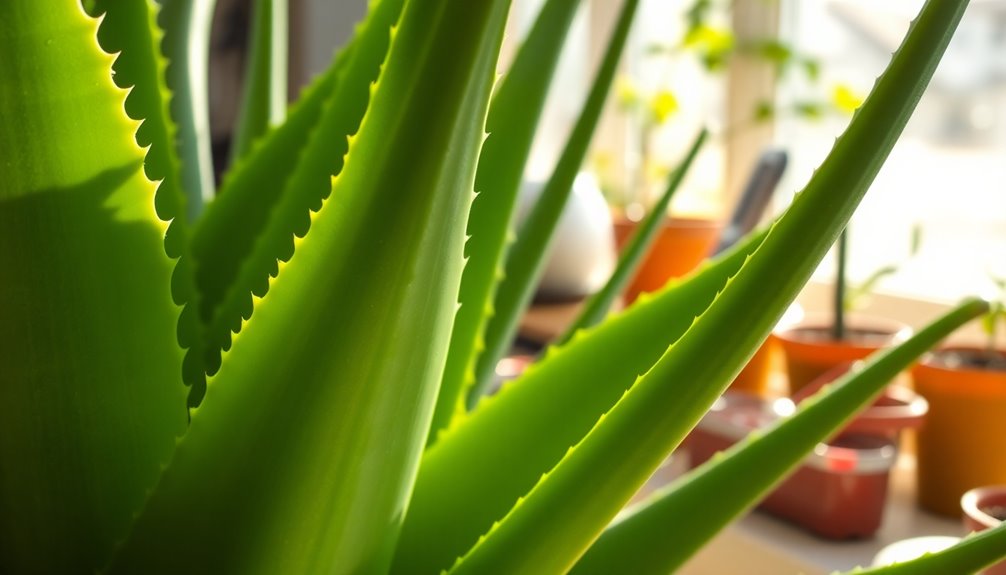
To successfully grow and maintain Aloe vera, it's vital to provide the right conditions for this resilient plant. Here are some tips to help you take care of your Aloe vera plants:
- Sunlight: Make sure your plant gets 6 to 8 hours of direct sunlight daily. This helps keep those thick leaves healthy and vibrant.
- Watering: Water every three weeks, letting the soil dry out slightly between waterings. Avoid overwatering, as it can harm the plant.
- Temperature: Keep your Aloe vera in a temperature range of 13 to 27°C. Protect it from temperatures below 27°F to prevent leaf damage.
Frequently Asked Questions
How to Fix a Droopy Aloe Vera Plant?
To fix a droopy aloe vera plant, first, check your watering schedule.
Make certain you're allowing the soil to dry out completely between waterings.
Then, assess its sunlight exposure; it needs 6 to 8 hours of direct sunlight daily.
If it's rootbound, repot it in well-draining soil.
Trim any dead leaves to promote new growth, and rotate the plant regularly to guarantee even light distribution for healthier foliage.
What Are the Secrets of Aloe Vera?
Imagine a wise old tree sharing secrets of healing. Aloe vera's gel soothes like a gentle breeze on sunburned skin, while its antioxidants battle the pesky invaders of aging.
It's been your ally for centuries, wrapping you in nature's embrace. Yet, beware the hidden dangers; not all parts of this plant are safe.
Embrace its gifts for beauty and healing, but always stay informed and cautious, ensuring you reap the best without any risk.
What Does an Overwatered Aloe Plant Look Like?
An overwatered aloe plant looks pretty sad.
You'll notice yellowing leaves that may feel soft or mushy. Look for brown, translucent spots on the leaves; those indicate root rot. The leaves might droop and lose their firmness, making your plant appear weak.
If the soil stays wet for too long, you might even smell something foul.
To help it recover, let the soil dry out and improve drainage.
What Is the Folklore of Aloe Vera?
Aloe vera's folklore is rich and fascinating. You might've heard that it's considered a sacred plant, believed to possess magical healing properties.
Many cultures see it as a protective charm, warding off negativity when kept in the home. Ancient tales often describe it as a gift from the gods, symbolizing immortality and serving as a remedy for both physical and spiritual ailments.
You can find comfort in its history as a symbol of well-being.
Conclusion
To summarize, you've discovered that aloe vera isn't just a simple succulent; it's a sensational source of healing and health. From its historical heritage to its modern marvels, this remarkable plant proves to be a powerhouse of potential. Whether you're cultivating it in your garden or incorporating its benefits into your beauty routine, aloe vera offers a wealth of wonders. So, go ahead—grow, use, and enjoy the many miraculous merits of this magical marvel!
Cindy thoroughly researches juicing trends, techniques, and recipes to provide readers with practical advice and inspiration. Her writing style is accessible, engaging, and designed to make complex concepts easy to understand. Cindy’s dedication to promoting the advantages of juicing shines through her work, empowering readers to make positive changes in their lives through the simple act of juicing.

